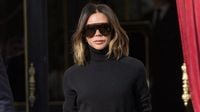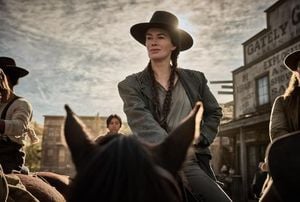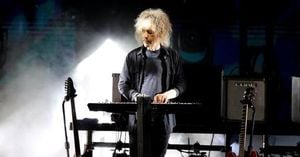Paris Fashion Week Spring/Summer 2026 has once again proven why the City of Light remains the epicenter of global style. Over a dazzling nine days, Paris hosted 74 shows and 37 presentations, delivering a season packed with landmark debuts, bold creative statements, and a few unexpected twists that have the fashion world buzzing. From storied maisons reinventing their DNA to designers making their much-anticipated first appearances, the week was a testament to both tradition and transformation.
On the opening day, the iconic Saint Laurent set the bar high with a show staged beneath the glowing Eiffel Tower. Anthony Vaccarello, the creative force behind the brand, leaned into his signature aesthetic—razor-sharp tailoring, fluid draping, and a sensual minimalism that whispered rather than shouted. The collection was a study in contrasts: strong-shouldered jackets brushed up against slinky, asymmetrical dresses, while oversized leather bombers played off sheer, ethereal fabrics. The runway was a supermodel summit, featuring legends like Linda Evangelista, Kate Moss, and Carla Bruni, as well as Bella Hadid, who turned heads in a translucent black trenchcoat accessorized with oversized sunglasses and statement earrings. According to reporting by Vogue, the models strode through a garden of white hydrangeas arranged in the YSL logo, with the Eiffel Tower providing a backdrop that was nothing short of cinematic. Vaccarello’s vision was clear: Saint Laurent is as timeless as ever, but also deeply attuned to how women want to dress today—boldly, with intent, and always with an edge.
Meanwhile, Louis Vuitton offered a softer, more intimate take on luxury. Nicolas Ghesquière, known for his futuristic tendencies, surprised guests by embracing the comfort of home—albeit elevated to Vuitton’s standards. The show took place in the newly restored summer apartments of Anne of Austria at the Louvre, a venue that underscored the collection’s theme of domestic dressing. As WWD described, Ghesquière sent out coats with teddy-bear textures, bathrobe-inspired outerwear, fuzzy knits, and toga-like dresses that balanced playfulness with serenity. Even the most relaxed looks—cotton tops, wide-legged silk trousers, and socks with glossy brocade sandals—carried a sense of luxe ease. The setting reinforced the vibe: guests wandered through the Louvre’s gilded halls, past masterpieces and antiques, while Cate Blanchett’s voice floated overhead, reading Talking Heads’ “This Must Be the Place.” In Ghesquière’s world, home is where comfort and couture meet.
Courrèges, under the direction of Nicolas Di Felice, continued to draw attention for its innovative approach. On September 30, 2025, Di Felice transformed the Carreau du Temple in the Marais into a circular runway, reflecting a “solar” theme that progressed from cool blues to fiery sunset tones. As reported by the Associated Press, the collection emphasized futuristic minimalism—think black boots seamlessly merging into socks, silver wrist clasps, and sheeny black shades. Yet beneath the sanitized, stripped-back mood pulsed a subtle eroticism: a coatdress unzipped nearly to the crotch, bare skin flashing beneath, and shoulderless minis trailing dramatic trains. Di Felice’s technical cleverness was on full display, as he balanced the brand’s space-age legacy with the energy of modern club culture. The result? A steady buildup of light and heat, culminating in a white-hot finale that left the crowd buzzing.
Dries Van Noten brought a breath of optimism and color to the proceedings with a collection inspired by surfing and the rhythm of the sea. Creative director Julian Klausner channeled the spirit of the ocean, sending models down the runway in shades of lemon, lime, tangerine, and bright green. Sheer kaftans shimmered with sequins that mimicked sunlight on water, while rhinestone-trimmed shifts rippled with movement. Klausner’s trademark contrasts were everywhere: sculptural wool tops reminiscent of wetsuits paired with diaphanous skirts, military coats in canary yellow and midnight velvet, and playful accessories like slim, rainbow-hued sneakers. As Vogue noted, the effect was couture-meets-coastline—part surfer, part grand fantasy, and entirely Dries. The collection proved that fashion can balance strength and softness, utility and fantasy, much like riding the perfect wave.
No Paris Fashion Week would be complete without a statement from Stella McCartney, and this season, she did not disappoint. The show at the Centre Pompidou opened with Helen Mirren reciting the Beatles’ “Come Together,” setting a tone that was both poetic and political. McCartney’s collection featured sharp boxy suits, marshmallowy dresses, and cocktail looks adorned with feather-free “Fevvers”—the world’s first plant-based alternative to feathers. Alex Consani glided down the runway in lilac ruffles, embodying McCartney’s commitment to glamour without cruelty. “Brands who continue to use feathers are choosing cruelty over creativity,” McCartney declared, as quoted in Vogue. The message was unmistakable: the future of fashion is both bold and planet-conscious.
Beyond the runways, Paris Fashion Week was abuzz with the personal style statements of industry icons. Victoria Beckham, known for her clean-cut silhouettes and quiet luxury, was seen on the streets of Paris ahead of her own Spring/Summer 2026 show, sporting a golden anklet with a diamond-like gem—a subtle nod to bohemian flair. As reported by Hello!, Beckham is expanding her jewelry line to include anklets, marking a shift from her usual minimalism. Anklets, as fashion historians remind us, have a storied past dating back to ancient Mesopotamia, Egypt, and the Indus Valley, where they signified status, beauty, and cultural identity. Today, they’re a mainstay on the high street, with brands like Thomas Sabo, Pandora, Abbott Lyon, Astrid & Miyu, and Lily & Roo offering a variety of styles.
The week was also notable for its wave of landmark debuts. Among the most anticipated were Jonathan Anderson at Dior, Miguel Castro Freitas at Mugler, Mark Thomas at Carven, Jack & Lazaro at Loewe, Glenn Martens at Maison Margiela, Pierpaolo Piccioli at Balenciaga, Duran Lantink at Jean Paul Gaultier, and Matthieu Blazy at Chanel. Each brought a unique vision to their respective houses, promising a new era for some of fashion’s most storied names.
With so many creative forces converging in one city, it’s no wonder Paris Fashion Week remains the industry’s most anticipated event. The collections this season didn’t just look to the past or chase fleeting trends—they offered a glimpse into fashion’s future, one where tradition and innovation walk hand in hand. Whether it was the quiet confidence of Saint Laurent, the cozy luxury of Louis Vuitton, the club-ready futurism of Courrèges, the sun-drenched optimism of Dries Van Noten, or Stella McCartney’s eco-conscious glamour, Paris reminded us all: when it comes to fashion, the world still looks to the City of Light for inspiration.




